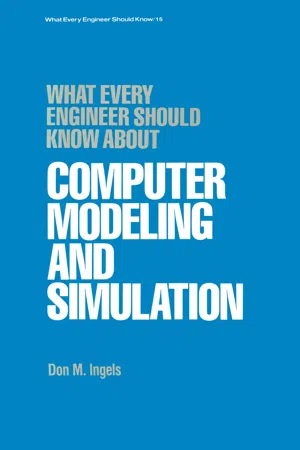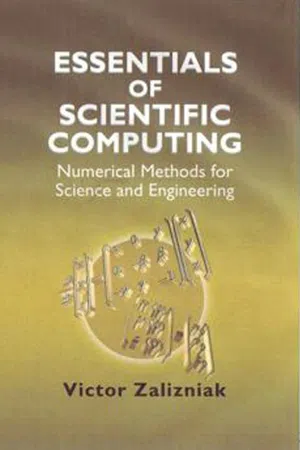Mathematics
Solving Linear Systems
Solving linear systems involves finding the values of variables that satisfy multiple linear equations simultaneously. This can be done using methods such as substitution, elimination, or matrix operations. The goal is to determine the unique solution, no solution, or infinitely many solutions for the system of equations.
Written by Perlego with AI-assistance
Related key terms
Related key terms
1 of 4
Related key terms
1 of 3
5 Key excerpts on "Solving Linear Systems"
- eBook - ePub
- Toby Wagner(Author)
- 2021(Publication Date)
- Chemeketa Press(Publisher)
Chapter 2 , we learned that a linear equation in two variables has infinitely many solutions. In other words, there are infinitely many combinations of variable values (ordered pairs) that will make the equation true. When graphed, all of the solutions make a straight line.If we need to find a particular solution, then we must be given more than one equation.Here is a problem like that:This problem may seem confusing and raise a lot of questions: Exactly what does “solve” mean in this case? How can we solve more than one equation at a time? How can we solve anything by graphing? Before tackling this problem, we need to understand systems of equations and revise our definition of the word “solution.”After completing this section, you should be able to: ◆ Recognize a system of equations and a solution for a system of equations ◆ Graphically interpret systems with one solution, no solution, or infinitely many solutions ◆ Solve a system of linear equations graphically — by hand and with a graphing calculatorA. Solution of a System
A set of two linear equations using two variables is called a system of linear equations in two variables. For short, we can call it a system of equations. For example, this pair of equations is a system of equations:The big, curvy grouping symbol to the left of the equations is called a brace, and it’s used to show that the two equations occur together and at the same time.Before we move forward, let’s remember a couple of things from Chapter 2 :◆ We know that an ordered pair is a set of two numbers that are written in a particular order. They are written in parentheses, like this: (2, 7). In this case, the first number, 2, represents the x - Don M. Ingels(Author)
- 2021(Publication Date)
- CRC Press(Publisher)
SOLVING THE MATHEMATICAL MODELThough this be madness, yet there be method in’t.[Shakespeare]5.1 INTRODUCTIONAs mentioned in Chapter 2 , writing down a set of equations might constitute a model, but equations are of little use unless they can be solved. The two basic solution approaches are: (1) analytical and (2) numerical. The analytical techniques are more informative and efficient to use, but much less general in their range of applicability, i.e., it is common to have equations with no known explicit analytic solution. These will be left to texts on mathematics [13 , 14 ]. Because of their general usefulness, the material in this book is restricted to a discussion of some useful numerical procedures that are commonly used in computer simulations.Two different classes of problems are encountered when modeling systems with sets of equations, whether the equations are linear or nonlinear. These two categories are:- n equations in n unknowns
- m equations in n unknowns, m < n
with k inequalities in n unknowns, where k can be any number. If the equations in class 1 problems are independent, they can usually be solved by methods such as those described below. Class 2 problems are solved using optimization techniques, linear programming [1 ] for linear systems, and nonlinear programming techniques [2 , 3 , 7 ] for nonlinear systems.
A set of linear equations can be written as:5.2 LINEAR ALGEBRAIC SYSTEMS(5.1)a11x 1+a12x 2+ ⋯ +a1 nx n=b 1a21x 1+a22x 2+ … +a2 nx n=b 2⋮an 1x 1+an 2x 2+ … +an nx n=b nwhere x1 … xn are the n unknowns, aij are known coefficients, and bi are known constants.If the number of equations is large, somewhere over four, writing them out explicitly soon becomes tedious and then they are most frequently expressed in array notation in terms of a matrix A and two vectors, x and b.- eBook - ePub
Essentials of Scientific Computing
Numerical Methods for Science and Engineering
- Victor Zalizniak(Author)
- 2008(Publication Date)
- Woodhead Publishing(Publisher)
3Solving systems of linear equations
This chapter considers one of the cornerstones of numerical analysis, namely, solving systems of linear equations. Various properties of systems of linear equations (such as structure, definiteness, and conditionality) are discussed. The main principles of direct methods are considered briefly, just to provide the information needed to use modern software. Particular emphasis is placed on the iterative methods because, in many instances, they are more efficient than the direct methods.Notation A ={ anm}matrix (uppercase bold letter) x vector (lowercase bold letter) N matrix or vector size ||·|| matrix or vector norm A T , x T transposed matrix or vector (x , y )=x T y dot product of vectors x and y SPD symmetric positive definite (matrix) det(A ) matrix determinant diag(a 1 , …, aN)diagonal matrix with elements a 1 , …, aNI identity matrix (I =diag(l, …, 1)) A −1 inverse matrix (A −1 A =I ) ɛpprescribed accuracy for calculating the approximate solution epperturbation error eaalgorithm error e τ rounding error x* true solution of a linear system (Ax*≡f ) x (k )k th approximation to the true solution e (k )= x* −x(k )error of k th approximation r (k )=Ax(k )−fresidual vector z n (B ) n th eigenvector of matrix B λn(B )n th eigenvalue of matrix B s (B )=max| λn(B )|spectral radius of matrix B N ops total number of operations (additions and multiplications/divisions) required to solve a system of linear equations 3.1 LINEAR ALGEBRA BACKGROUND
To begin with, we will consider some basic definitions from linear algebra needed for understanding of matrix computations. We will restrict our consideration to the case when matrices and vectors are real. Vectors, then, are objects of the N-dimensional Euclidean spaceRN. A list of the operations defined inRN - eBook - ePub
- James R. Kirkwood, Bessie H. Kirkwood(Authors)
- 2020(Publication Date)
- Chapman and Hall/CRC(Publisher)
numbers (s 1, …, s n) for which a 1 s 1 + ⋯ + a n s n = b. The solution set to the equation a 1 x 1 + ⋯ + a n x n = b is the set of all solutions to the equation. A system of linear equations in the variables x 1, …, x n is a finite set of linear equations of the. form a 11 x 1 + ⋯ + a 1 n x n = b 1 a 21 x 1 + ⋯ + a 2 n x n = b 2 ⋮ a m 1 x 1 + ⋯ + a m n x n = b m A solution to the system of equations above is an ordered n -tuple of numbers (s 1, …, s n) that is a solution to each of the equations in the system. The set of all possible solutions is called the solution set of the system. Exercises In Problems 1–3 determine whether the given values form a solution to the system of. equations 1. 2 x + y − z = 5 x + y = 2 2 y − z = 1 x = 2, y = 0, z = − 1. 2. x − y = 4 2 x + 3 y = 5 x = 17 5, y = − 3 5 3. x − y + 2 z = 0 3 x − 2 y = 4 y + z = 3 x = 1, y =. − 1, z = − 1. 4. Which of the following are linear equations? If an equation is not a linear equation, tell why. (a.) 3 x − x y + 2 z = 7 (b.) 3 a − 4 b = 7 (c.) sin (30 °) x − 4 y − 7 z = 0 (d.) w − 5 x + 4 z = 0 (e.) 4 sin x + y 2 + 3 z = − 5 (f.) 3 w − 2 y = 6 z = − 8 Section 2.2 Solving Systems of Linear Equations (Gaussian Elimination) The solution set of a system of linear equations has an important property that. is not necessarily shared by equations that are not linear; namely, there is either (i) No solution. (ii) Exactly one solution. (iii) Infinitely many solutions. We will see why this is the case later in this chapter. Definition: A system of linear equations that has either exactly one solution or infinitely many solutions is said to be consistent. A system of linear equations that has no solutions is inconsistent. We give an example of each possibility. Example For the system 2 x − 3 y = 5 x + 3 y = − 2 there is exactly one solution, namely x = 1, y = −1 - eBook - ePub
Linear Algebra
An Inquiry-Based Approach
- Jeff Suzuki(Author)
- 2021(Publication Date)
- CRC Press(Publisher)
2Systems of Linear Equations
In this chapter, we’ll consider the problem of solving systems of linear equations. This is a critical part of linear algebra, and we offer the following general strategy:Strategy. Every problem in linear algebra begins with a system of linear equations.2.1 Standard Form
When trying to work with a collection of objects, it’s easiest if they’re all in some standardized format. You’ve seen such standardized formats before: it’s convenient to rewrite a given quadratic equation in the forma; it’s convenient to write the equation of a line in the formx 2+ b x + c = 0y = m x + b; and so on. In this activity, we’ll develop a standard form for a system of linear equations.Activity 2.1: Standard Form We’ll say that an equation has been reduced to simplest form if it has as few terms as possible.A2.1.1 The equation3 x − 5 y = 8has three terms: 3x, 5y, and 8. If possible, rewrite the equation so it has fewer terms; if not possible, explain why not.A2.1.2 The equation2 x + 7 z = 1 + 2 y + 5 xhas five terms. If possible, rewrite the equation so it has fewer terms; if not possible, explain why not.A2.1.3 The equation5 x − 2 y + z + 12 = 0has five terms. If possible, rewrite the equation so it has fewer terms; if not possible, explain why not.Activity 2.1 motivates the following definition:Definition 2.1 (Standard Form). A linear equation is in standard form when- All of the variables are on one side of the =,
- The constant is on the other side of the =.
As Activity 2.1 shows, equations in standard form will have fewer terms than equations not in standard form.In Activity A1.3.2, we represented linear equations as vectors. If we have a system of equations, we can represent the entire system as a collection of vectors and, as long as all
Index pages curate the most relevant extracts from our library of academic textbooks. They’ve been created using an in-house natural language model (NLM), each adding context and meaning to key research topics.
Explore more topic indexes
Explore more topic indexes
1 of 6
Explore more topic indexes
1 of 4




